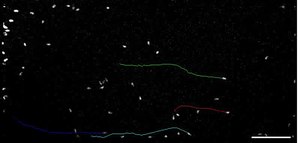Phototaxis
| Parent |
|
Taxi's response to light stimulus |
| Subordinate |
| negative / positive phototaxis plant movement |
| Gene Ontology |
|---|
| QuickGO |
As Phototaxis a by differences will illuminance (Beleuchtungsstärkengradient) in its direction influenced locomotion designated by organisms. Positive phototaxis describes the movement in the direction of higher illuminance, negative phototaxis the movement in the direction of lower illuminance. In an amphitropic phototaxis , some organisms of a group of similar organisms move in the direction of higher illuminance and some in the direction of lower illuminance.
Organisms can react differently to different illuminance levels. Some flagellates show a positive phototaxis in weak lighting and negative phototaxis in stronger lighting. Some organisms also react differently to different light wavelengths : Phototrophic bacteria often react positively phototactically to light wavelengths that are absorbed by their phototrophic pigments, while they do not react phototactically or negatively to light of other wavelengths.
Some organisms move at certain angles to the incidence of light; in this case one speaks of slide or transversal phototaxis .
The first description of the phototaxis comes from Gottfried Reinhold Treviranus in 1803 with green swarmers , which he published in 1817. Since then, phototactic reactions have been observed in almost all animal groups. All of these organisms must inevitably have some form of light receptor .
Phototaxis must not be confused with photokinetics. This form of reaction to light is independent of differences in illuminance; it depends on the absolute illuminance. Photokinetics is a dependence of the speed of movement on the intensity of the light radiation. With positive photokinesis, an organism moves faster when there is a stronger incidence of light; with negative photokinesis, it moves more slowly. A number of organisms do not move at all in the dark (dark rigor), others stop their movement when light falls on them (light rigidity). The resulting curve of the photokinesis is usually an optimum curve .
Phototaxis in zooplankton
Phototaxis in zooplankton has been well studied in the marine annelid Platynereis dumerilii :
Platynereis dumerilii Trochophora - and Metatrochophora larvae are positive phototaxis. Phototaxis in these larvae is mediated by simple eye spots, which consist of a pigment cell and a photoreceptor cell . The photoreceptor cell forms synapses directly to eyelash cells , with which the larvae swim and control. The eye spots do not create a spatial image, so the larvae rotate to scan their surroundings for the direction of light.
Platynereis dumerilii Nektochaeten larvae can switch between positive and negative phototaxis. Phototaxis is mediated in them by two pairs of more complex definite eyes ( pigment cup cells ). These eyes have more photoreceptor cells that are shaded by pigment cells. The photoreceptor cells do not form direct synapses to eyelash or muscle cells, but to interneurons of a billing center. The information from all four eyes can be calculated into a low-resolution image with four pixels so that the larva knows where the light is coming from without rotating. This is an adaptation to the life on the seabed, where the nectochaete larvae reside, whereby the scanning with rotation is more suitable for trochophora larvae, which live in the open water column. The nectochaete larvae of Platynereis dumerilii react phototactically over a large wavelength range which is covered by at least three opsins that are expressed by the definite eyes: two rhabdomeric opsins and one go-opsin.
literature
- P. Kröger, P. Hegemann: Photophobic responses and phototaxis in Chlamydomonas are triggered by a single rhodopsin photoreceptor. In: FEBS Letters . Volume 341, Number 1, March 1994, pp. 5-9, ISSN 0014-5793 . PMID 8137921 . (Review).
- P. Hegemann : Vision in microalgae. In: Planta. Volume 203, Number 3, 1997, pp. 265-274, ISSN 0032-0935 . PMID 9431675 . (Review).
- D. Bhaya: Light matters: phototaxis and signal transduction in unicellular cyanobacteria. In: Molecular microbiology. Volume 53, Number 3, August 2004, pp. 745-754, ISSN 0950-382X . doi: 10.1111 / j.1365-2958.2004.04160.x . PMID 15255889 . (Review).
Individual evidence
- ↑ Johan Abraham Bierens de Haan: The animal instincts and their remodeling through experience: an introduction to general animal psychology . Brill Archive, January 1, 1940, p. 113 ( books.google.de ).
- ↑ Textbook of Plant Physiology . Springer-Verlag, 2013, ISBN 978-3-642-96453-4 , p. 494 ( books.google.de ).
- ^ E. Riklis: Photobiology The Science and Its Applications . Springer Science & Business Media, 2012, ISBN 978-1-4615-3732-8 , pp. 497 ( limited preview in Google Book search).
- ↑ Peter Hegemann, Georg Nagel: From channel rhodopsins to optogenetics. In: EMBO Molecular Medicine. 5, 2013, p. 173, doi: 10.1002 / emmm.201202387 .
- ↑ Barry SC Leadbeater, John C. Green: Flagellates Unity, Diversity and Evolution . CRC Press, 2002, ISBN 978-0-203-48481-4 , pp. 124 ( limited preview in Google Book search).
- ↑ a b c Nadine Randel, Albina Asadulina, Luis A Bezares-Calderón, Csaba Verasztó, Elizabeth A Williams, Markus Conzelmann, Réza Shahidi, Gáspár Jékely: Neuronal connectome of a sensory-motor circuit for visual navigation . In: eLife . 3, May 27, 2014. doi : 10.7554 / eLife.02730 .
- Jump up ↑ Gáspár Jékely, Julien Colombelli, Harald Hausen, Keren Guy, Ernst Stelzer, François Nédélec, Detlev Arendt: Mechanism of phototaxis in marine zooplankton . In: Nature . 456, No. 7220, November 20, 2008, pp. 395-399. doi : 10.1038 / nature07590 .
- ↑ a b Martin Gühmann, Huiyong Jia, Nadine Randel, Csaba Verasztó, Luis A. Bezares-Calderón, Nico K. Michiels, Shozo Yokoyama, Gáspár Jékely: Spectral Tuning of Phototaxis by a Go-Opsin in the Rhabdomeric Eyes of Platynereis . In: Current Biology . 25, No. 17, August 2015, pp. 2265–2271. doi : 10.1016 / j.cub.2015.07.017 .
- ↑ N. Randel, LA Bezares-Calderon, M. Gühmann, R. Shahidi, G. Jekely: Expression Dynamics and Protein Localization of Rhabdomeric Opsins in Platynereis Larvae . In: Integrative and Comparative Biology . 53, No. 1, May 10, 2013, pp. 7-16. doi : 10.1093 / icb / ict046 .


